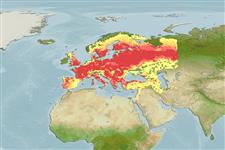Classification / Names
Common names from other countries
Main reference
Size / Weight / Age
Max length : 70.0 cm SL male/unsexed; (Ref. 44894); common length : 20.0 cm TL male/unsexed; (Ref. 556); max. published weight: 7.5 kg (Ref. 556)
Length at first maturity
Lm ?, range 20 - ? cm
Environment
Freshwater; brackish; demersal; potamodromous (Ref. 51243); depth range 1 - ? m (Ref. 26368)
Climate / Range
Temperate; 4°C - 24°C (Ref. 13614), preferred ?; 64°N - 36°N, 10°W - 104°E
Distribution
Eurasia: hypothesized as native in most Europe, naturally absent only in Ireland, Scandinavia north of 61°30'N, eastern Adriatic basin and western and southern Greece where it is now introduced. In Asia, native eastward to western Yenisei drainage south of 60° N. Introduced elsewhere.
Countries | FAO areas | Ecosystems | Occurrences | Introductions
Short description
Dorsal
spines
(total): 4;
Dorsal
soft rays
(total): 8-9;
Anal
spines: 3-4;
Anal
soft rays: 6 - 8;
Vertebrae: 39 - 41. Body thickset, heavy, and laterally compressed, the caudal peduncle characteristically deep and short. Skin thickened, slimy; the scales small, embedded. Overall coloration olive-green, at times dark green or almost black, with golden reflections on ventral surface. Head triangular, eye orange-red, small; snout relatively long; interorbital broad; mouth terminal, small in size with thick lips and a pair of well-developed barbels, one at each corner of the mouth. Caudal fin with 19 rays (Ref. 2196). Diagnosed from other cyprinid species in Europe by the following characters: body golden greenish brown; one pair of barbel (maxillary); lateral line with 96-115 scales, small and deeply embedded; dorsal fin with 8-9½ branched rays; and anal fin with 6-9½ branched rays (Ref. 59043).
IUCN Red List Status (Ref. 115185)
Threat to humans
Harmless
Human uses
Fisheries: commercial; aquaculture: commercial; gamefish: yes; aquarium: public aquariums
Tools
Special reports
Download XML
Internet sources
Estimates of some properties based on models
Phylogenetic diversity index
PD50 = 1.0000 many relatives (e.g. carps) 0.5 - 2.0 few relatives (e.g. lungfishes)
Trophic Level
3.7 ±0.0 se; Based on diet studies.
Resilience
Medium, minimum population doubling time 1.4 - 4.4 years (tm=2; tmax=10; Fec=120,000-800,000)
Vulnerability
High vulnerability (65 of 100)
Price category
